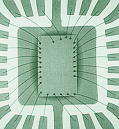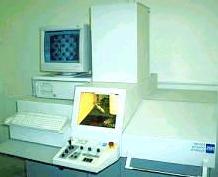X-Ray
Radiography
X-Ray
Radiography is a nondestructive
semiconductor failure
analysis technique used to examine the interior
details of the package. It operates on the principle of
dissimilar
transmission of X-Rays through different materials.
The ability of a material to block X-Rays increases with its
density. It is this dissimilar transmission of X-rays through different
materials that is utilized to create an image of various contrasts.
X-Ray imaging may be accomplished on film, by fluoroscopy, or by
using image intensifying video systems.
A
typical modern X-Ray inspection equipment has a filament that produces an
electron beam used to
excite a target into producing
X-Rays. The X-Ray
emissions are then directed to and transmitted through the specimen. The
transmitted
X-Rays are collected by a detector, translated into electric
signals, amplified, and transformed into an X-Ray image.
The
varying densities of the various materials comprising the specimen allow
different amounts of X-Rays to pass through, resulting in varying
grayscale levels on the
X-Ray image.
The quality of the X-Ray image formed therefore depends not only
on the proper operation of the X-Ray equipment used, but on the
composition of the specimen as well. Some materials used in
semiconductor assembly, such as aluminum wires, are transparent to X-Ray,
and are therefore invisible in X-Ray images.
 |
|
Fig. 1.
Example of a Top View X-ray Photo of an IC |
X-Ray
radiography is commonly used to inspect for
wiresweeping and other
wirebond problems, die attach voids, package voids and cracks. It is
excellent for determining leadframe outlines as well. Traditional x-ray
systems use photosensitive films to record the x-ray image. Since X-Rays
are not easy to focus, this method produces low-resolution images, which
greatly limits its usefulness.
 |
|
Fig. 2.
Example of an X-ray Inspection System |
Today, X-Ray systems use a
microspot
source, real-time detection and automated manipulation of the sample to
achieve higher resolution and throughput. These systems are capable of
detecting much finer package details and defects.
See Also:
Failure
Analysis; All
FA Techniques;
Optical
Inspection;
Sectioning;
Acoustic
Microscopy; FA Lab
Equipment; Basic FA
Flows;
Package Failures; Die
Failures
HOME
Copyright
© 2001-2005
www.EESemi.com.
All Rights Reserved.

